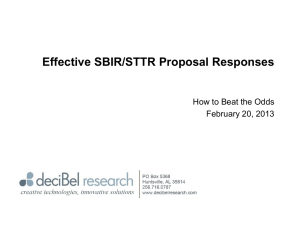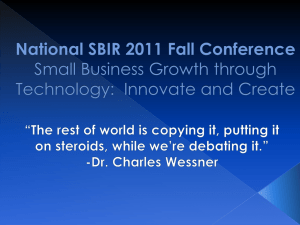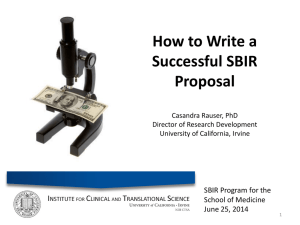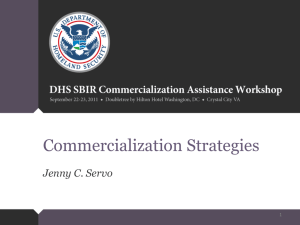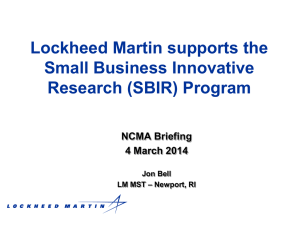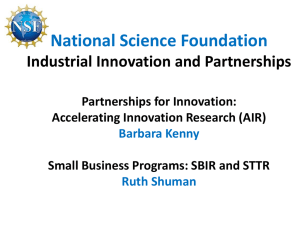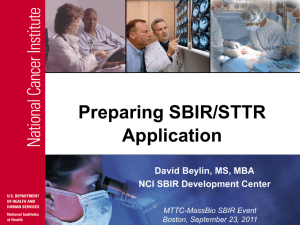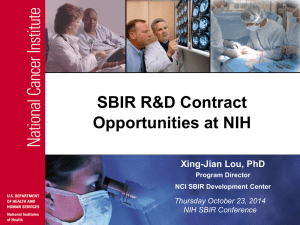AAPM SBIR & STTR - North Carolina Biotechnology Center
advertisement
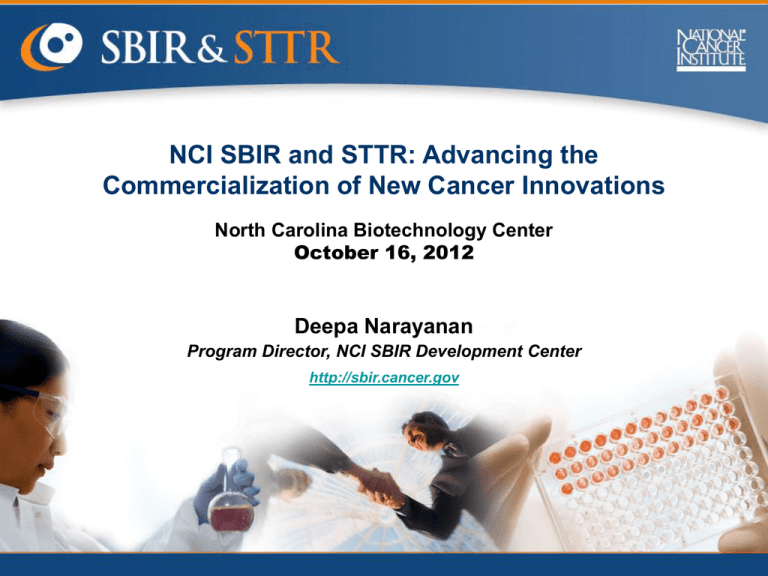
NCI SBIR and STTR: Advancing the Commercialization of New Cancer Innovations North Carolina Biotechnology Center October 16, 2012 Deepa Narayanan Program Director, NCI SBIR Development Center http://sbir.cancer.gov Today’s Presentation • SBIR/STTR Overview & Eligibility • Congressional Reauthorization & Policy Directives • Key Changes • Update on SBA Policy Directives for Implementing Changes • Funding Opportunities at NCI/NIH • Priority Areas & Focused Solicitations • NCI’s SBIR Program • NCI SBIR Development Center • Phase II Bridge Award • Investor Forum • Tips on Preparing a Successful SBIR Application 2 Congressionally Mandated Programs Set-Aside (FY13) Small Business Innovation Research (SBIR) Set-aside program for small business concerns to engage in Federal R&D with the potential for commercialization 2.7% Federal agencies with an extramural R&D budget > $100M Small Business Technology Transfer (STTR) Set-aside program to facilitate cooperative R&D between small business concerns and U.S. research institutions with the potential for commercialization 0.35% Federal agencies with an extramural R&D budget > $1B 3 SBIR/STTR Funding Levels 2010 Budget SBIR STTR SBIR+STTR NIH $616M $74M $690M NCI $99M $12M $111M ← The annual SBIR/STTR budget for each participating Institute or Center (IC) is proportional to the total annual budget appropriation for that IC NIGMS NIDDK 4 Reasons to Seek SBIR/STTR Funding • One of the largest sources of early stage life sciences funding in the country. • A stable and predictable source of funding • Intellectual property rights are retained by the small business concern • Not a loan – no repayment is required • Funding is non-dilutive capital • Can be a leveraging tool to attract other funding • Projects undergo NIH’s rigorous scientific peer review SBIR Eligibility Applicant must be a Small Business Concern (SBC) Organized for-profit U.S. business 500 or fewer employees, including affiliates PD/PI’s primary employment (i.e., >50%) must be with SBC at the time of award and for duration of the project period ≥ 51% U.S.- owned by individuals and independently operated * OR ≥ 51% owned and controlled by another (one) business concern that is ≥ 51% owned and controlled by one or more individuals * * Recent reauthorization includes some exceptions to this rule 6 STTR Eligibility Applicant is a Small Business Concern Formal Cooperative R&D Effort • Minimum 40% by small business concern • Minimum 30% by U.S. research institution U.S. Research Institution: College or University; Non-profit research organization; Federally-Funded R&D Center (FFRDC) Intellectual Property Agreement • Should provide the necessary IP rights (to the SBC) in order to carry out follow-on R&D and commercialization Principal Investigator’s primary employment may be with either the Small Business Concern or the research institution 7 SBIR & STTR: Three-Phase Program • Proof-of-Concept study • $150,000 over * 6 months (SBIR) or 1 year (STTR) • Commercialization stage • Use of non-SBIR/STTR funds Fast-Track Application Phase I Phase II Combined Phase I & II FEASIBILITY DEVELOPMENT Phase III COMMERCIALIZATION • Research & Development • Commercialization plan required • $1 million over 2 years* 8 SBIR/STTR Reauthorization: Key Changes 9 Congressional Reauthorization • SBIR/STTR programs were re-authorized through FY2017 by the 2012 Defense Authorization Act (P.L.112-81) • New law includes a range of important changes to the programs • US Small Business Administration (SBA) is responsible for providing policy guidance on how to implement changes • Increases SBIR set-aside (incrementally) from 2.5% to 3.2% by 2017. • Increases STTR set-aside from 0.30% to 0.45% by 2017 • Establishes hard caps on funding levels for Phase I & II awards • $225K for Phase I • $1,500K for Phase II 10 Changes to Eligibility Venture Capital Participation NIH will be allowed to spend up to 25% of SBIR funds on small businesses majority owned by multiple VCs, hedge funds, or private equity firms. Previously not allowed. In effect after Size Rules are finalized, expected 1/1/13. Cross-Program Awards STTR Phase I awardees can receive SBIR Phase II awards, and vice versa Cross-Agency Awards Phase I awardee may receive a Phase II award from a different agency Direct to Phase II pilot Phase II SBIR awards may be awarded without requiring Phase I award. Not yet clear what NIH implementation will be. …and other proposed eligibility changes Focus on Commercialization Expanded Technical Assistance • Increased funding for technical assistance ($5000 per award) • This can be provided through NIH technical assistance programs, i.e. Niche Assessment Program (Phase I), or Commercialization Assistance Program (Phase II), or requested by the awardee • STTR awardees now eligible (previously not allowed) Commercialization Readiness Program • Allows NIH up to 10% of SBIR/STTR funds to support commercialization and Phase III efforts Company Commercialization Record • Applicants will be required to provide information on commercialization of prior SBIR/STTR awards …and other proposed commercialization initiatives Improving the SBIR/STTR Programs Streamlining the Award Process Working to shorten timelines from application to award decision. NIH given 1 year from solicitation close date. Administrative Funding Pilot 3% of SBIR funds for agencies to provide support to improve: • Outreach • Commercialization • Streamlining & Simplifying the Award Process What can we do to make the program better for you? Comment on Policy Directives & tell your Program Officers Implementation Timeline Effective New Program Element Now Set-aside increases, FY12 SBIR = 2.6% STTR = 0.35% With next issued solicitation • • • • January 1, 2013 (expected) • Size Rule finalized • Company Registry registration required • New eligibility requirements re: ownership & affiliation 150% award caps Open Phase II competitions SBIR to STTR/STTR to SBIR Cross-agency awards http://grants.nih.gov/grants/funding/sbir/reauthorization.htm For More Information • Sign up for NCI mailing list for updates at: http://sbir.cancer.gov • Visit: http://sbir.gov • For more info about NIH-specific implementation visit: http://grants.nih.gov/grants/funding/sbir/reauthori zation.htm • Speak with your program officer SBIR/STTR Funding Opportunities 16 Multiple Funding Solicitations Know the Application Deadlines SBIR & STTR Omnibus Solicitations for Grant Applications Release: January Receipt Dates: April 5, August 5, and December 5 Solicitation of the NIH & CDC for SBIR Contract Proposals Release: August Receipt Date: Early November See the NIH Guide for other Program Announcements (PA’s) and Requests for Application (RFA’s), i.e. grants Release: Weekly Receipt Dates: Various http://grants.nih.gov/grants/guide 17 http://sbir.nih.gov 18 http://sbir.cancer.gov 19 NCI Program Announcements Innovative Health IT for Broad Adoption by Healthcare Systems & Consumers (PA-12-196) Goal: Accelerate development & commercialization of evidence-based consumer health IT to (1) Prevent or reduce the risk of cancer (2) Facilitate patient-provider communication (3) Improve disease outcomes in consumer & clinical settings • Next receipt date December 5, 2012, April 5 2013, August 5 2013 Image Guided Cancer Interventions (PA-10-079 & PA-10-080, SBIR/STTR) Goal: Accelerate development & optimization of integrated image guided intervention systems for cancer imaging, monitoring, therapy. • Next receipt date December 5, 2012 Cancer Diagnostic &Therapeutic Agents Enabled by Nanotechnology (PAR-10-286) Goal: Accelerate the translation and commercialization of promising nanotechnologyderived cancer therapeutics and in vivo diagnostics from the advanced discovery phase to the end of preclinical characterization. • Next receipt date November 9 2012, March 8. 2013, July 8 2013 SBIR Contracts 21 SBIR Contracts vs. Grants Funding Solicitations for SBIR Grants Funding Solicitation for SBIR Contracts Scope of the proposal Investigator-defined within the mission of NIH Defined by the NIH (focused) Questions during solicitation period? May speak with any Program Officer MUST contact the contracting officer Receipt Dates 3 times/year for Omnibus Only ONCE per year Basis for Award Based on score during peer review If proposal scores well during peer review, must then negotiate to finalize deliverables with NIH Reporting One final report (Phase I); Annual reports (Phase II) Monthly or quarterly progress reports Set-aside of funds for particular areas? NO YES 22 NCI SBIR Contracts Areas of interest to the commercial sector, based on market opportunity NCI scientific & technology priorities Contract topics in areas with strong potential for commercial success $25,020 NCI SBIR contracts (thousands) $16,665 $12,387 13% 2007 25% $7,757 17% % of total NCI SBIR 8% 2008 2009 2010 23 Contract Opportunities Now Available PHS-2013-1 “Solicitation of NIH and CDC for SBIR Contract Proposals” Published August 15, 2012: Proposals Due: November 13, 2012 RFP can be found at: http://grants.nih.gov/grants/funding/SBIRContract/PHS2013-1.pdf More info about NCI’s topic areas: http://sbir.cancer.gov/funding/contracts/ FY13 NCI SBIR Contract Topics Therapeutics & Diagnostics • 313 RNAi Cancer Therapeutics using Nanotechnology • 315 Development of Companion Diagnostics: Enabling Precision Medicine in Cancer Therapy • 316 Development of CTC Isolation Technologies Enabling Downstream Single Cell Molecular Analysis Advancing Cancer Research • 314 Development of Human Tissue Culture Systems that Mimic the Tumor Microenvironment • 319 Technology to Generate Anti-Peptide Capture Reagents for AffinityEnriched Proteomic Studies • 320 High Quality Cancer-Related Standards for Metabolomics Research • 321 Chemically Defined Glycan Libraries for Reference Standards and Glycomics Research (Joint NCI-NIGMS Program) 25 FY13 NCI SBIR Contract Topics Imaging & Radiation Therapy • 323 Development of Radiation Modulators for Use During Radiotherapy • 324 Novel Imaging Agents to Expand the Clinical Toolkit for Cancer Diagnosis, Staging, and Treatment • 325 Innovative Radiation Sources for Advanced Radiotherapy Equipment Health IT • 322 Real-Time Integration of Sensor and Self-Report Data for Clinical and Research Applications NIH Technology Transfer • 317 Wound Healing Preparations Incorporating Nitric OxideReleasing Materials • 318 Test to Predict Effectiveness of Docetaxel Treatment for Prostate Cancer 26 Topic 323: Development of Radiation Modulators for Use During Radiotherapy* Budget: Phase I $300,000; Phase II $1.5M Number of Anticipated Awards: 3 - 5 Goal: Development of radiosensitizers, radioprotectants, or radiomitigators that decrease normal tissue injury and/or enhance tumor killing. Phase I Activities & Deliverables Include: • In vitro testing • Clonogenic survival studies • Preliminary in vivo toxicity studies Phase II Activities & Deliverables Include: • In vivo experiments • PK/PD in rodent model • GMP drug production/sourcing • IND approval *Re-issue 27 Topic 314: Development of Human Tissue Culture Systems that Mimic the Tumor Microenvironment Budget: Phase I $300,000; Phase II $2M Number of Anticipated Awards: 3 - 5 Goal: Development of 3D human tissue model culture systems that accurately mimic the tumor microenvironment…validated against known effective anticancer agents Phase I Activities & Deliverables Include: • Develop 3D culture system prototype that incorporates human tumor cells using or easily adapted for use with high content screening platforms • Demonstrate accurate prediction of clinical efficacy in the developed prototype benchmarked against 2D and currently available 3D systems Phase II Activities & Deliverables Include: • Benchmark performance against known in vivo effects • Demonstrate ability to scale-up system 28 Topic 317: Wound Healing Preparations Incorporating Nitric Oxide-Releasing Materials (NIH Technology Transfer) Budget: Phase I $200,000; Phase II $1.5M Number of Anticipated Awards: 1 Fast-Track proposals not accepted Goal: Develop a wound-healing dressing using NCI-developed NO-releasing material technology. *Contractor will be granted royalty-free, non-exclusive license but is encouraged to submit an application for a commercialization license to NIH OTT Phase I Activities & Deliverables Include: • Prototype development • Material characterization • Proof of concept in vitro studies • In vivo efficacy studies Phase II Activities & Deliverables Include: • Stability studies • Capacity for commercial production & manufacture 29 Questions About Contracts? Ms. Bette Shanahan eshanahan@mail.nih.gov 301.435.3782 http://sbir.cancer.gov/funding/contracts/ 30 New Paradigm for Managing SBIR at NCI Activities of Center • Active outreach to bring in a new class of commercially viable applicants • Coaching companies on developing stronger applications • Active management of projects and better oversight • Mentor and guide companies throughout the award period • Matchmaking with investors NCI SBIR Development Center Program Staff Michael Weingarten, MA (Director) Andrew J. Kurtz, PhD (Lead Program Director) Previous • NASA – Program Manager, NASA Technology Commercialization Program Previous • NIH – AAAS Science & Technology Policy Fellow • Cedra Corporation – Research Associate, BioAnalytical Assays and Pharmacokinetics Analysis Greg Evans, PhD (Lead Program Director) Jian Lou, PhD (Program Director) Previous • NHLBI/NIH – Program Director, Translational and Multicenter Clinical Research in Hemoglobinopathies • NHGRI/NIH – Senior Staff Fellow Previous • Johnson & Johnson – Research Scientist, Target Validation & Biomarker Development • Lumicyte, Inc. – Director, Molecular Biology Systems Analysis Patti Weber, DrPH (Program Director) Todd Haim, PhD (Program Director) Previous • International Heart Institute of Montana – Tissue Engineering and Surgical Research • Ribi ImmunoChem Research, Inc. – Team Leader, Cardiovascular Pharmacology Previous • National Academy of Sciences – Christine Mirzayan Science and Technology Policy Fellow • Pfizer Research Laboratories – Postdoctoral Fellow, Cardiac Pathogenesis & Metabolic Disorders Deepa Narayanan, MS (Program Director) Amir Rahbar, PhD, MBA (Program Director) Previous • Naviscan PET Systems, Inc., Director, Clinical Data Management (Oncology Imaging & Clinical Trials) • Fox Chase Cancer Center, Scientific Associate (Molecular Imaging Lab) Previous • NCI– Program Manager, Center for Strategic Scientific Initiatives • BioInformatics, LLC – Senior Science Market Analyst • Naval Research Laboratory – Research Scientist Jennifer Shieh, PhD (AAAS Science & Ming Zhao, PhD (Program Director) Technology Policy Fellow) Previous Previous • National Academy of Sciences – Christine Mirzayan Science and Technology Policy Fellow • Syapse, Inc. – Biology Associate • NCI– Program Director, Center to Reduce Cancer Health Disparities • GE Global Research – Senior Scientist • Pfizer – Scientist 33 SBIR Phase IIB Bridge Award 34 NCI SBIR Phase IIB Bridge Award Phase I FEASIBILITY Phase II DEVELOPMENT NCI SBIR Phase IIB Bridge Award CROSSING THE VALLEY OF DEATH Phase III COMMERCIALIZATION • Incentivize partnerships with third-party investors & strategic partners earlier in the development process • Involves another peer-review cycle to evaluate progress & future plans • Up to $1M per year for up to 3 years to extend selected projects • Open to any NIH-funded Phase II awardees • Competitive preference and funding priority to applicants that can raise substantial third-party funds (i.e., ≥ 1:1 match) FY13 Receipt Dates: November 6, 2012 & March 6, 2013 Program Funding Solicitation Eligibility • Current Phase II awards & and those that ended within the last 2 years • Cancer-related Phase II projects initially funded by other NIH institutes • Special Review to Evaluate Technical and Commercial Merits • Reviewers are academics, clinicians, industry professionals, venture capitalists • Emphasizes important commercialization considerations such as intellectual property (e.g., patents) and strategy for gaining FDA approval • Requires complete disclosure of applicant’s SBIR commercialization history Third-Party Fundraising plan • Preferred Types of Funds: Cash, liquid assets, convertible debt • Sources of Funds: Another company, venture capital firm, individual “angel” investor, foundation, university, state or local government, or any combination 36 Partnership Benefits Benefits to the NCI • Opportunity to leverage millions of dollars in external resources • Valuable input from third-party investors: 1. Rigorous commercialization due diligence prior to award 2. Commercialization guidance during the award 3. Additional financing beyond the Bridge Award project period Benefits to third-party investors • Opportunity to partner with small businesses to develop & commercialize: 1. Technologies that have been vetted by NIH peer-review, AND 2. Projects for which substantial proof-of-concept data already exists Opportunity to share in the early-stage investment risk with the NCI 37 “Valley of Death” Applicants must provide a concise “Statement of Need” that includes answers to the following questions: • What is the perceived “Valley of Death” for the product/technology? • Why is additional government funding critically needed to accelerate the development of the product or technology toward commercialization? • What activities are being proposed that would not otherwise be possible through independent third-party investments OR would be significantly delayed without additional NIH support? • To what extent would a possible award advance the product or technology far enough to attract sufficient, independent third-party financing and/or strategic partnerships to carry out full commercialization? 38 12 Bridge Awards (to date) FY Company Technology/Product Award Size 2009 Lpath Therapeutics Humanized monoclonal antibody for treatment of prostate cancer $3,000,000 2009 Optosonics Photoacoustic CT for preclinical molecular imaging $2,997,247 2009 Guided Therapeutics Fluorescence/reflectance spectroscopy for detection of cervical cancer $2,517,125 2009 Koning Corporation High-performance breast CT as diagnostic adjunct to mammography $2,986,453 2009 Gamma Medica-Ideas Molecular imaging to detect metabolic activity of breast lesions $3,000,000 2009 Altor BioScience Tumor-targeted immunotherapy for treatment of p53-positive cancers $2,969,291 2010 20/20 GeneSystems mTOR companion diagnostic assay $2,750,000 2010 Advanced Cell Diagnostics In situ RNA detection assay for analyzing circulating tumor cells $2,996,450 2010 Ambergen Expression-based prognostic assay for recurrence of colorectal cancer $2,998,830 2010 Praevium Research High-performance imaging engine for optical coherence tomography $1,180,420 2011 Wilson Wolf Manufacturing Moving TIL therapy past the Valley of Death $1,006,256 2011 Oncoscope Validation & commercialization of a/LCI for detection of esophageal neoplasia $2,999,084 3 therapeutics 6 imaging technologies 3 molecular diagnostics http://projectreporter.nih.gov/reporter.cfm 39 12 Bridge Awards (to date) $20,000,000 NCI Funding Third-Party Funding $15,000,000 $10,000,000 $5,000,000 $0 NCI Total $31,401,156 Venture Capital: Third-Party Investments $72,695,374 Strategic Partners: 1/3 > 2 to 1 Individuals & Other: 1/3 Leverage 1/3 40 NCI SBIR Investor Forum Exclusive opportunity for some of the most promising NCI-funded companies to showcase their technologies http://sbir.cancer.gov/investorforum/ • Opportunity to pitch and network with >150 investors and potential strategic partners • Features NCI’s top portfolio companies with innovative technologies Previous Presenters • Zacharon Pharmaceuticals, Inc. • Omniox, Inc. • ImaginAb, Inc. • Fluxion Biosciences • Exclusive one-on-one meetings 41 What Does It Take to Get Funded? Tips on Applying When is an SBIR/STTR application appropriate? • Innovative solution to significant clinical and/or research need (e.g. Rx, Dx, research tools) • Significant commercial potential • Collaboration with SBC: Need involvement of a commercial partner • Start-up: Too early for private investment • Established SBC: No resources to try new approach, but board supports SBIR • Leverages company/PI expertise When NOT to apply • Need cash urgently • SBIRs take 8-16 months or more to get and you must start with Phase I (~$225K) • Incremental upgrade: no change to clinical paradigm • “Me too” product matching competitor’s capabilities • Basic Research - commercial and clinical value is not clear Before You Write an Application • Consider your company’s strengths • Consider your company’s weaknesses • Contact NIH Program Director in advance (more than 1 week before due date!) to discuss your proposal concept and receive feedback • Review similar, currently funded NIH projects Search Previous Awards RePORTER http://projectreporter.nih.gov Key Application Tips • Start Early • Strong proposals take time to develop • Take care of the administrative registrations (SF424) • http://sbir.nih.gov > Electronic Submission • Take Time to Refine the Vision • Start informal discussions with potential customers, technical experts, investors, commercialization experts to clarify the product vision • Assemble the right team • Assemble a strong scientific team • Get outside partners to fill knowledge and expertise gaps (academic collaborators, consultants, other companies) • Know your Reviewers • Identify the most appropriate Institute/Center • Identify the most appropriate study section BEFORE you submit your application • Review your Application before you Submit Know NIH Review Criteria Significance • Does the product address an important problem, and have commercial potential? Is there a market pull for the proposed product? Approach • Are design and methods well-developed and appropriate? Are problem areas addressed? Innovation • How novel is the product and the approaches proposed to test its feasibility? Investigator • Is the investigator appropriately trained and capable of managing the project? Environment • Does the scientific environment contribute to the probability of success? Is the environment unique? Commercialization • Is the company’s business strategy one that has a high potential for success? 48 Other Tips for a Strong Application • Significant, innovative, and focused science • Make the SBIR/STTR application product-focused, as distinct from an R01 • Generate preliminary data, if possible • Include letters of support from KOLs, end-users, possible investors. • Explain the key issues and controversies in the product space; describe the competition and your value proposition • Identify any unanswered questions, and then contact NCI SBIR program staff for help • Write clearly • Prepare your application early! 49 If you aren’t funded … Use peer review to improve your technology and presentation Reviewers often spot errors in the proposal Reviewers will let you know if what you are proposing has been done before If peer reviewers “didn’t get your proposal” Customers, investors, and employees may not get it either Fix errors, improve your presentation It’s always painful not to be funded, but at least you get the feedback Explore opportunities to serve on NIH peer review panels Deepa Narayanan SBIR Program Director Cancer Imaging and Radiation Therapy NCI SBIR Development Center Phone: 301.594.0212 narayanand@mail.nih.gov http://sbir.cancer.gov Topic 313: RNAi Cancer Therapeutics Using Nanotechnology Budget: Phase I $200,000; Phase II $1M Number of Anticipated Awards: 3 - 5 Goal: …design, fabrication, characterization, and preclinical evaluation of novel nanoparticle-based drug formulations capable of delivering candidate RNAi therapeutics for the treatment of cancer Phase I Activities & Deliverables Include: • Demonstrate nanoconstruct stability in vitro, and demonstrate controlled release of RNAi therapeutic agent(s) • In vitro efficacy studies in relevant cancer cell line(s) • Establish specificity of RNAi therapeutic and its phenotypic effects • Small in vivo efficacy study in relevant animal model of cancer Phase II Activities & Deliverables Include: • In vivo preclinical efficacy • Safety, pharmacokinetics and pharmacodynamics • R&D activities needed to complete an IND application 52 Topic 314: Development of Human Tissue Culture Systems that Mimic the Tumor Microenvironment Budget: Phase I $300,000; Phase II $2M Number of Anticipated Awards: 3 - 5 Goal: Development of 3D human tissue model culture systems that accurately mimic the tumor microenvironment…validated against known effective anticancer agents Phase I Activities & Deliverables Include: • Develop 3D culture system prototype that incorporates human tumor cells using or easily adapted for use with high content screening platforms • Demonstrate accurate prediction of clinical efficacy in the developed prototype benchmarked against 2D and currently available 3D systems Phase II Activities & Deliverables Include: • Benchmark performance against known in vivo effects • Demonstrate ability to scale-up system 53 Topic 315 Companion Diagnostics* Budget: Phase I $300,000 ; Phase II $1,500,000 Number of Anticipated Awards: 4 Goal: Companion diagnostics for selecting patients for which a particular therapeutic regimen, including existing drugs and those in clinical development and radiation, will be safe and effective Phase I Activities & Deliverables Include: • Test development and analytical validation • If the drug is not commercially available, establish partnership w/ developer Phase II Activities & Deliverables Include: • Full clinical validation *Re-issue Topic 316: Development of CTC Isolation Technologies Enabling Downstream Single Cell Molecular Analysis Budget: Phase I $300,000; Phase II $1.5M Number of Anticipated Awards: 4 Goal: Demonstrate technical viability of technology to isolate and analyze CTCs at the single-cell level in an experimental setting. Phase I Activities & Deliverables Include: • Method for CTC isolation or identification amenable to downstream singlecell analysis • Isolate or identify CTCs from samples with counts as low as 1 cell/ml of blood • Provide CTCs for molecular analysis at the single-cell level Phase II Activities & Deliverables Include: • Prototype demonstrating applications with significant clinical utility, such as whole genome sequencing, molecular phenotyping, or culture for ex vivo analysis • Test device with patient samples • Establish marketing partnership 55 Topic 317: Wound Healing Preparations Incorporating Nitric Oxide-Releasing Materials (NIH Technology Transfer) Budget: Phase I $200,000; Phase II $1.5M Number of Anticipated Awards: 1 Fast-Track proposals not accepted Goal: Develop a wound-healing dressing using NCI-developed NO-releasing material technology. *Contractor will be granted royalty-free, non-exclusive license but is encouraged to submit an application for a commercialization license to NIH OTT Phase I Activities & Deliverables Include: • Prototype development • Material characterization • Proof of concept in vitro studies • In vivo efficacy studies Phase II Activities & Deliverables Include: • Stability studies • Capacity for commercial production & manufacture 56 Topic 318: Test to Predict Effectiveness of Docetaxel Treatment for Prostate Cancer (NIH Technology Transfer) Budget: Phase I $300,000; Phase II $2M Number of Anticipated Awards: 1 Fast-Track proposals not accepted Goal: Develop genetic test based on CYP1B1*3 variant to predict clinical outcome of docetaxel patients and guide therapeutic strategy. *Contractor will be granted royalty-free, non-exclusive license but is encouraged to submit an application for a commercialization license to NIH OTT Phase I Activities & Deliverables Include: • Develop array-based genotyping technique • Retrospective validation • Identify percentage of patient samples with CYP1B1*3 variant Phase II Activities & Deliverables Include: • Clinical trial • Develop commercially-viable prototype 57 Topic 319: Technology to Generate Anti-Peptide Capture Reagents for Affinity-Enriched Proteomic Studies Budget: Phase I $200,000; Phase II $1M Number of Anticipated Awards: 4 Goal: New technologies that generate reproducible, well-characterized antipeptide capture reagents for use in affinity-enriched proteomic studies. Phase I Activities & Deliverables Include: • Capture reagents that reliably immunoprecipitate target peptides • Affinity reagents to at least 10 proteotypic peptides • Coordination with the Clinical Proteomic Technologies for Cancer (CPTC) community Phase II Activities & Deliverables Include: • Develop at least 100 anti-peptide capture reagents • Demonstration whether antibodies can immunoprecipitate full-length proteins • Benchmark performance criteria against current technology 58 Topic 320: High Quality Cancer-Related Standards for Metabolomics Research Budget: Phase I $200,000; Phase II $1M Number of Anticipated Awards: 3 – 5 Goal: Develop labeled and unlabeled metabolite standards for use with mass spectrometry (MS) and/or nuclear magnetic resonance (NMR) spectroscopy. Phase I Activities & Deliverables Include: • Synthesize 10-1000 labeled or unlabeled compounds on a pilot scale for a given metabolic pathway • Verify structures of synthesized compounds • Run pilot MS or NMR validation tests Phase II Activities & Deliverables Include: • Scale up synthesis, purification, and formulation of Phase I deliverables • Validate metabolite standards set for reproducible performance in MS or NMR as appropriate • Provide letters of interest from potential customers 59 Topic 321: Chemically Defined Glycan Libraries for Reference Standards and Glycomics Research (Joint NCI-NIGMS Program) Budget: Phase I $300,000; Phase II $1M Number of Anticipated Awards: 4 – 6 Goal: Synthesis & commercial distribution of robust, well-characterized new carbohydrate libraries for use as standards. Phase I Activities & Deliverables Include: • Synthesize defined library (20-50 compounds) of representative glycans • Verify structures of synthesized compounds by NMR • Provide samples to NIGMS-designated screening center for validation testing Phase II Activities & Deliverables Include: • Expand glycan library to at least 100 compounds • Scale up synthesis, purification, structural verification, and packaging • Provide letters of interest from potential customers to purchase the product 60 Topic 324: Novel Imaging Agents to Expand the Clinical Toolkit for Cancer Diagnosis, Staging, and Treatment* Budget: Phase I $250,000; Phase II $1.5M Number of Anticipated Awards: 3 - 5 Goal: Development of novel imaging agents for: • Early detection & diagnosis of cancer • Differentiation of benign disease from malignancy • Stratification of patients for the purpose of selecting a cancer therapy • Surgical planning • Evaluation of tumor response to chemotherapy & radiation therapy • Detection of cancer recurrence Phase I Activities & Deliverables Include: • Prepare imaging agent with high signal-to-noise ratio • Proof-of-concept preclinical studies • Preliminary toxicological studies Phase II Activities & Deliverables Include: • Demonstrate fast in vivo clearance, stability, bioavailability, etc. • Demonstrate high reproducibility & accuracy in several animal models *Re-issue 61 Topic 322: Real-Time Integration of Sensor and SelfReport Data for Clinical and Research Applications Budget: Phase I $200,000; Phase II $1M Number of Anticipated Awards: 2 – 3 Goal: Secure, privacy-compliant mobile applications and paired analytic systems to control the collection, transfer, integration, analysis, and reporting of objective and self-reported health-related measures. Phase I Activities & Deliverables Include: • Establish project team with broad expertise • Prototype including front-end mobile application(s), integration with sensors, and back-end user-interface controls for data integration Phase II Activities & Deliverables Include: • Beta-test and finalize: • Front-end mobile application • File transfer, screening, data importation protocols and systems • Data integration and visualization tools • User-interface systems • Usability testing 62 Topic 323: Development of Radiation Modulators for Use During Radiotherapy* Budget: Phase I $300,000; Phase II $1.5M Number of Anticipated Awards: 3 - 5 Goal: Development of radiosensitizers, radioprotectants, or radiomitigators that decrease normal tissue injury and/or enhance tumor killing. Phase I Activities & Deliverables Include: • In vitro testing • Clonogenic survival studies • Preliminary in vivo toxicity studies Phase II Activities & Deliverables Include: • In vivo experiments • PK/PD in rodent model • GMP drug production/sourcing • IND approval *Re-issue 63 Topic 324: Novel Imaging Agents to Expand the Clinical Toolkit for Cancer Diagnosis, Staging, and Treatment* Budget: Phase I $250,000; Phase II $1.5M Number of Anticipated Awards: 3 - 5 Goal: Development of novel imaging agents for: • Early detection & diagnosis of cancer • Differentiation of benign disease from malignancy • Stratification of patients for the purpose of selecting a cancer therapy • Surgical planning • Evaluation of tumor response to chemotherapy & radiation therapy • Detection of cancer recurrence Phase I Activities & Deliverables Include: • Prepare imaging agent with high signal-to-noise ratio • Proof-of-concept preclinical studies • Preliminary toxicological studies Phase II Activities & Deliverables Include: • Demonstrate fast in vivo clearance, stability, bioavailability, etc. • Demonstrate high reproducibility & accuracy in several animal models *Re-issue 64 Topic 325: Innovative Radiation Sources for Advanced Radiotherapy Equipment Budget: Phase I $300,000; Phase II $2M Number of Anticipated Awards: 2 - 3 Goal: Development of innovative radiation sources that could reduce the cost and footprint of radiation treatment systems. Phase I Activities & Deliverables Include: • Design and build proof-of-principle prototype system • Characterize beam parameters Phase II Activities & Deliverables Include: • Prototype radiation source with clinically acceptable parameters • Demonstrate that system is capable of delivering treatment dose in clinically acceptable period of time in an anthropomorphic system *Re-issue 65
